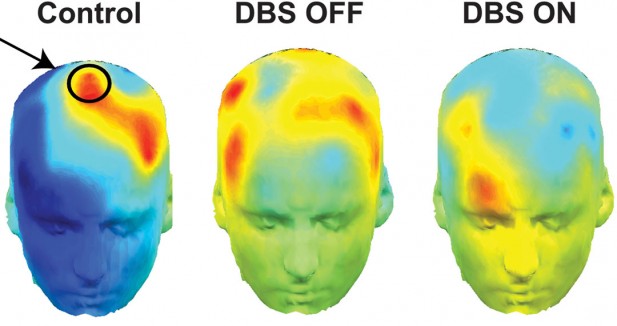
© Frank Lab/Brown UniversityThe hotter the color, especially in the circled area, the more likely the brain was to take its time making difficult decisions. Parkinson’s patients whose deep brain stimulators were on (right), were more impulsive — a cooler blue.
Some people who receive deep brain stimulation for Parkinson's disease behave impulsively, making quick, often bad, decisions. New research published in
Nature Neuroscience explains why, and shows that under normal circumstances key parts of the brain collaborate to buy time for careful consideration of difficult decisions.
Take your time. Hold your horses. Sleep on it.
When people must decide between arguably equal choices, they need time to deliberate. In the case of people undergoing deep brain stimulation (DBS) for Parkinson's disease, that process sometimes doesn't kick in, leading to impulsive behavior. New research into why that happens has led scientists to a detailed explanation of how the brain devotes time to reflect on tough choices.
Michael Frank, professor of cognitive, linguistic, and psychological sciences at Brown University, studied the impulsive behavior of Parkinson's patients when he was at the University of Arizona several years ago. His goal was to model the brain's decision-making mechanics. He had begun working with Parkinson's patients because DBS, a treatment that suppresses their tremor symptoms, delivers pulses of electrical current to the subthalamic nucleus (STN), a part of the brain that Frank hypothesized had an important role in decisions. Could the STN be what slams the brakes on impulses, giving the medial prefrontal cortex (mPFC) time to think?
"We didn't have any direct evidence of that," said Frank, who is affiliated with the Brown Institute for Brain Science. "To test that theory for how areas of the brain interact to prevent you from making impulsive decisions and how that could be changed by DBS, you have to do experiments where you record brain activity in both parts of the network that we think are involved. Then you also have to manipulate the system to see how the relationship between recorded activity in one area and decision making changes as a function of stimulating the other area."
Frank and his team at Brown and Arizona did exactly that. They describe their findings in a study published online in the journal
Nature Neuroscience.


